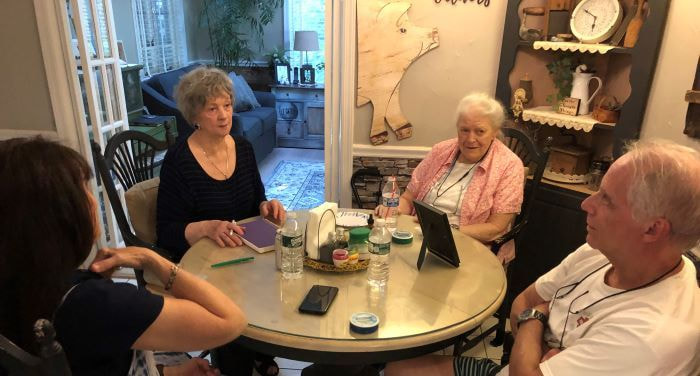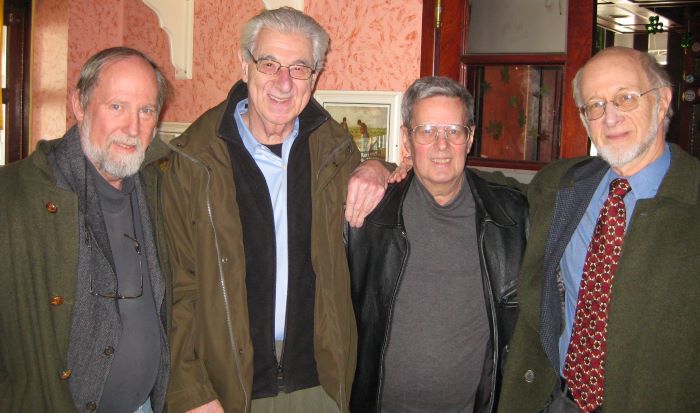|
Henry Aaron. Tommy Lasorda. Jim (Mudcat) Grant. Poring over the magnificent two-page spread in the Times, honoring prominent people who passed in 2021, I realized I could write reams about stars I knew from the locker rooms. I could also recall famous people I met here and there – Colin Powell, streetwise New Yorker ---- Vartan Gregorian, kind Armenian wise man -- and Larry Flynt, seedy champion of pornography, who happened to be a hilarious and incisive interview. But my heart, at year’s end, is remembering relatives and friends I got to know up close, who have left a personal gap. As Arthur Miller wrote: Attention must be paid. Aunt Lila. She was my wife’s aunt – helped raise her -- but she also became my aunt, jolly and chubby with a beautiful smile and a generous hug, over the decades, sidling up to me and asking about our children, our work (she had an admirable curiosity), and whether I knew the Lord. Her children and grandchildren cared for her in old age, shuttling her from northeast Connecticut to suburban Long Island, keeping her going, medically and socially. At a reunion last summer at a daughter’s home, Aunt Lila was wan, low on energy, and Marianne sat by her all afternoon, sensing this might be the last time, which it turned out to be. But Aunt Lila’s smiles and hugs and kind acceptance linger on. Captain Curt. Once a point guard on very good basketball teams at Hofstra, Curt Block became a publicist at NBC and had other memorable gigs. (As a young reporter, he interviewed young Cassius Clay, and had the presence of mind to keep the rudimentary tape, re-discovering it in old age.) When aging baseball and basketball players (and one scribe, me) began to meet periodically at Shaun Clancy’s great place, Foley’s, Curt took the slow train up from Philadelphia and became the greeter, the treasurer, the captain, sitting in the middle, enjoying everybody else’s stories, moving the ball around, as he had against Hofstra’s opponents, back in the day. He quietly alluded to impending heart surgery, and last summer he went to sleep and did not get up. Because of the pandemic, the old boys have not been able to meet since, to uniformly mourn our quiet leader. Neighbor and Nurse. Ann Schroeder was a nurse in the Bath-Brunswick area of Maine. She got to know my wife’s Uncle Harold (older brother of Aunt Lila) and she became a volunteer guide to his old-age miseries. We got to know her through her detailed emails, explaining Harold’s health problems, what was being done, so we could assure his relatives that he was surrounded by skilled, loving friends in that wonderful area that has become our own sentimental home. After Harold passed, we stayed in touch – via health newsletters Ann sent. She casually alluded to her own breathing issues, and last summer she noted that she was now on hospice, and then the e-mails stopped. In keeping with this understated woman, her service was private.
Mentor to Surly Luddites. Howard Angione was a reporter who somehow wandered into the emerging technology age at The New York Times, in the mid-1970s. With the reserved air of a theologian, he had to introduce temperamental reporters to the bulky Harris terminals now placed around the City Room. Sometimes these terminals would swallow articles whole, provoking profane tantrums from cranky news reporters like, well, like me. Howard’s motto was: “If I can teach Vecsey, I can teach anybody.” Which he could. After his missionary work in the City Room, Howard went to law school and specialized in elder law, until he became an elder himself. The NYT did not note the passing of the tutor who helped modernize the paper, but the Portland (Maine) Press-Herald did. Zone-Buster Poet. Stephen Dunn was a rather shy jump shooter who could beat down a zone defense. On one road trip, he heard two older Hofstra teammates discussing a novel, and he realized jocks could also be scholars – and later he began to write poetry, ultimately gaining a Pulitzer Prize. His later years were spent fighting Parkinson’s disease, which got so bad that he could not recite his own work. Our friend, once known as “Radar,” was deservedly included in the NYT’s gallery of notables in Friday’s year-end necrology. My Cousin Artie. From my earliest memories, I admired Art Spencer, my oldest cousin. He was so cool – riding a two-wheeler, driving a car one summer in rural Pennsylvania, with friends who had musty, mysterious barns amid lush corn fields, going to college, going into the military, marrying, starting a family. At family gatherings – some joyous, some sad – I had to practically pry out of him that he and Shirley had a flourishing crafts business, designing house signs – staples at weekend crafts exhibits near Ocala, Fla. The women in his family cared for him lovingly in his final months, and then staged – sign of the times – a Zoom service to honor an understated and artistic life. Agent and Friend. Philip Spitzer was my agent who negotiated a durable contract with a publisher and the manager of Loretta Lynn – a project in 1974 that turned out to be the book and the movie, “Coal Miner’s Daughter.” I can still see Philip -- suave, part French, athletic, sitting on Berney Geis’s rooftop patio in Manhattan, holding his own, word by word, paragraph by paragraph, with two legalistic sharpshooters. We became family friends, his three children, my three children, good memories, even if the guy would never, ever, let me win a tennis set or a basketball game. Even after we did not work together, we stayed in touch, and as his health deteriorated, he passed the Loretta project to his capable oldest child, Anne-Lise Spitzer. This magnificent seven stands in for all the people in my life who passed in 2021. As far as I know, Covid did not figure in any of their passing – just the inevitable erosion of time, long and good lives, now ended. Our best wishes to all who read this tribute. As one often hears in corners of New York: Be Well.
Alan D. Levine
12/31/2021 01:33:24 pm
A beautiful set of tributes, George.
Tom Schwarz
12/31/2021 02:52:08 pm
Lives well lived
Clemson Smith Muñiz
12/31/2021 02:27:07 pm
Hail to Aunt Lila, Captain Curt, Neighbor & Nurse, Mentor to Surly Luddites, Zone-Buster Poet, Cousin Artie and Agent & Friend. Each one of them made me smile and they will waft in my consciousness for that much longer. Thanks for sharing. Happy New Year to you & Marianne. Un abrazo.
George
12/31/2021 03:24:21 pm
Clemson: Saludos. Que sorpresa. Let's be in touch in new year.
shaun Clancy
12/31/2021 03:07:15 pm
The Magnificent Seven,may they Rest In Peace.
bruce
12/31/2021 03:18:01 pm
george,
Altenir Silva
12/31/2021 04:24:19 pm
George: They will stay forever in your memory. Thanks for sharing this text.
Ed Martin
12/31/2021 05:50:12 pm
On the Light, GV, Marianne, family and friends.
Randolph
12/31/2021 06:59:06 pm
George,
Andy Tansey
1/4/2022 05:40:00 am
Death is a time when many ponder thoughts about faith and Aunt Lila's Lord. It is not too profound a stretch to believe that there is eternal life - at least in some form - in the good influence the living take from those who have passed before them and, in turn, pass on to others. To me, George, your nice memories of these people help their good influences endure. Thank you.
Lawrence Dauch
1/20/2022 04:33:32 am
Hi Comments are closed.
|
Categories
All
|











